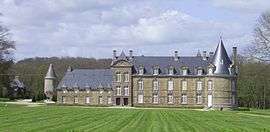Chateau de Canisy

Chateau de Canisy is a castle in Canisy, Normandy, France, constructed sometime in the 15th century. It is located about three hundred kilometers from Paris, and eight kilometers from Saint-Lo Cathedral, in the center of Normandy. The chateau is surrounded by 740 acres of forests, ponds, lakes, gardens and manicured lawns.[1]
Members of the Kergorlay family have owned the chateau for the past 1000 years. The ownership of the castle has been passed down to the oldest male heir in the family since the time it was built. At present time Comte Denis de Kergolay is the presiding owner of the Chateau de Canisy.
History
Construction
In 1066, the Lord of Canisy was Hugues de Carbonnel.[2] At that time there was a medieval chateau on the grounds and a fortified tower;[3] only a portion of these remain.
The present Chateau de Canisy was mainly constructed between 1558 and 1625 during the time that Herve de Carbonnel was presiding owner of the estate. He commissioned the architect Francois Gabriel to oversee the renovation. Local stone used on the exterior of the castle has a purple hue which at times appears to change color in the sunlight.[4]
The chateau has parapets and towers which were typical of the architectural design of that era.[4] At one time the chateau was surrounded by a moat, which has since been fill in.
World War II
In 1940 during the height of the second World War, German soldiers took over the Chateau, and occupied it until August 1944.[5] During that time Bridgette Kergorlay, daughter of the heir of the castle, was the translator between the German forces and her father, who spoke fluent German, but refused to speak to the German soldiers at all.
The surrounding commune of Canisy was part of the aerial saturation that was launched by the United States First Army being led by Omar Bradley.[6] During the battle of July 26, 1945 the commune was liberated when General Omar Bradley pushed his American troops through the German lines. This was known as Operation Cobra, which had a goal of creating a passage for the Allies to get from Normandy to Brittany. After liberation, the Chateau de Canisy was used as a hospital for the wounded Allied soldiers.
Restorations
During the occupation of the castle by the German forces and the ensuing battles accompanying the landing of the Allied forces there was severe damage to the structure of the chateau. Since that time the castle has undergone several restorations. In 1945 the French government classified it as a “Monument Historique” because of its historical and architectural importance.
During the one thousand years this castle and the surrounding grounds have been cared for by the Kergorlay family, some changes have been made to make life in the estate more modern and convenient, while maintaining as much as possible its original architectural heritage.[7]
Today
The Kergorlay family has opened the Chateau de Canisy as a historical castle, hotel and event venue. Rooms in the castle are decorated with furniture accumulated by the various Kergorlay owners throughout history, to represent specific time periods. Inside the castle there is also a library which contains many rare and collectible books.
Visitors to the castle can book rooms for overnight stays, and events such as weddings and conferences[8] are held on the grounds. Profits from these endeavors are used to keep the property and estate in good condition. As of 2014, the proprietor and manager of the estate is Compte Denis de Kergorlay.[9]
References
- ↑ "Directions to Chateau De Canisy, Canisy". LateRooms. 1970-07-20. Retrieved 2013-08-09.
- ↑ Sir Francis Palgrave (1864). The History of Normandy and of England: Richard-Sans-Peur. Richard Le-Bon. Richard III. Robert Le-Diable. William the Conqueror. 1864. J. W. Parker and son. pp. 661–.
- ↑ Peabod (10 March 2010). The Century Club. AuthorHouse. pp. 246–. ISBN 978-1-4490-7899-7.
- 1 2 NASSAU WILLIAM SENIOR (1880). CONVERSATIONS WITH DISTINGUISHED PERSONS. pp. 2–.
- ↑ Harold Baumgarten (2006). D-Day Survivor. Pelican Publishing. pp. 151–. ISBN 978-1-4556-0338-1.
- ↑ Thomas M. Hatfield (21 April 2011). Rudder: From Leader to Legend. Texas A&M University Press. pp. 173–. ISBN 978-1-60344-262-6.
- ↑ "vacation in Normandy near Paris by Jean-Pierre-Remy". Canisy. Retrieved 2013-08-09.
- ↑ John Dickie (28 May 2004). New Mandarins: How British Foreign Policy Works. I.B.Tauris. pp. 183–. ISBN 978-0-85771-511-1.
- ↑ Sneška Quaedvlieg-Mihailović (2004). Heritage and the Building of Europe. Maecenata Verlag. pp. 153–. ISBN 978-3-935975-32-2.
- ↑ Auguste Marie Hue (1890). Lichens de Canisy (Manche) et des environs. J. Mersch, imprimeur. pp. 75–.
External links
| Wikimedia Commons has media related to Château de Canisy. |
- "Alain-Marie de Kergorlay(1715-1787) : History of Canisy, our castle in Normandy". Canisy.com. Retrieved 2013-08-09.
